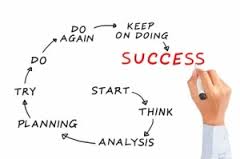How to Change a Habit That is Hurting You, Part 5
 My last four posts, How to Change a Habit That is Hurting You, Part I, Part II, Part III and Part IV were about the first four steps for changing a habit that is hurting you:
My last four posts, How to Change a Habit That is Hurting You, Part I, Part II, Part III and Part IV were about the first four steps for changing a habit that is hurting you:
(1) Make a decision, a declaration and a commitment to yourself.
(2) Surround yourself with reminders of what you are moving toward.
(3) Notice how often you engage in the behavior you want to change and what the impact is when you do.
(4) Examine and challenge your assumptions.
Now that you have identified the thinking that has been driving the habit you want to rise above, you can change your thoughts and consciously approach things in a whole new way. And this leads us to step five…
(5) Envision and practice a new way of doing things.
The focus of steps one through four is on dismantling an old, ingrained behavior. Step five is about substituting a new behavior for the old one – one that will truly serve you. And it is a good idea to have something to substitute your old habit with, so that instead of just focusing on moving away from something, you can put your energy and attention on what you are moving toward and the positive impact that will make in your life.
Chances are you already know what you’d like to do as an alternative. If not, you can ask yourself the question, “What would be a better way of handling situations like the ones that have been causing me trouble?” When you ask a question, your subconscious mind gets busy finding the answer for you. You may learn by watching or seeking mentoring from people around you who are masterful in the areas you strive to improve in. You may find yourself drawn to articles, books, workshops or other resources that will help you. You might journal about it and find yourself writing about the answer.
Once you have an idea of what you’d like to do differently, it is important to practice as often as you can, both physically and mentally. When you are engaging in step three, reviewing the events of a situation where you may have fallen back into an old pattern, you can ask yourself what you could have done differently and then play the movie in your mind that has you acting in the new way and experiencing how good it would feel. Research has shown that mentally rehearsing in this way allows the brain to create the same neural pathways that are formed through physical rehearsal.
It is important to be patient and kind with yourself as you learn a new behavior. It will probably be somewhat uncomfortable or at the very least unnatural at first. You will likely not be very good at it right away. And you may find it tempting to say “the heck with it” and revert back to your old behavior as a result. But stick with it. With consistent practice it will get easier and it will come more naturally, until finally the new behavior is so engrained that you won’t have to think about it all that much.
In review, here are the five steps for changing a habit that is hurting you:
(1) Make a decision, a declaration and a commitment to yourself.
(2) Surround yourself with reminders of what you are moving toward.
(3) Notice how often you engage in the behavior you want to change and what the impact is when you do.
(4) Examine and challenge your assumptions.
(5) Envision and practice a new way of doing things.
These steps don’t have to happen in a linear sequence. Sometimes you will be at step three for awhile, noticing how often you are falling into old patterns (and experiencing the pain of them) before you are ready to move to step one, making a commitment to change. Sometimes they happen simultaneously - like when you reflect on your behavior (step three) and then envision what you could do differently next time (step five). Often when you begin the practice in step five, you begin to become aware of limiting assumptions you can challenge with step four.
You can accelerate your progress with each of these steps by working with a coach. A good coach can not only help you get really clear on your desired results but also assist you in identifying thoughts, behaviors and habits getting in your way that you may not even be aware of. Working with a coach can help you to stay accountable to yourself while being supported through change that can be uncomfortable. And a good coach can help you to identify alternate ways of doing things that are aligned with your natural strengths. Coaching also allows you the opportunity to try out new behaviors in a safe environment, while getting honest, constructive feedback that your colleagues, friends and family may be hesitant to share.
 If you are interested in learning more about coaching, visit https://dianebolden.com/coaching.html or contact me to schedule a complimentary coaching call. And if you are more of a “do it yourselfer”, check out my new video program, On the Road to Real or my book, The Pinocchio Principle: Becoming the Leader You Were Born to Be, available at Amazon.com or BarnesandNoble.com.
If you are interested in learning more about coaching, visit https://dianebolden.com/coaching.html or contact me to schedule a complimentary coaching call. And if you are more of a “do it yourselfer”, check out my new video program, On the Road to Real or my book, The Pinocchio Principle: Becoming the Leader You Were Born to Be, available at Amazon.com or BarnesandNoble.com.
Image courtesy of pakorn at FreeDigitalPhotos.net
